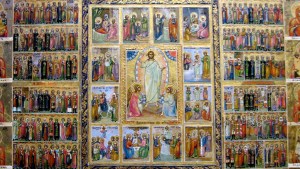Children discover and live their faith first and foremost within their family. But they must gradually come to realize that they belong to the Church. One does not belong to the Church the way one belongs to a political party, a club or a charity. In the Church, there are no honorary members or sympathizers. There are, and there can only be, active members, members living in and through the Church. “Christ and the Church are one,” said Joan of Arc. One cannot belong to Christ, live for Him and through Him without belonging to the Church and living within it. To help the child understand all this, he or she does not need great speeches but clear, specific points of reference.
A new Liturgical Year is about to begin, but it often goes unnoticed, even in Christian families. The new school year and the new calendar year are marked by important activities or special festivities, but more often than not, we start the new Liturgical Year without realizing it. However, the Liturgical Year gives rhythm to the prayer and life of the Church, and thus to the life of each of its members.
Calendar and liturgical notebook
Display a liturgical calendar in the prayer corner or children’s room, or make one. You can start one that you will complete throughout the year. To do this, prepare a strip of strong paper or cardboard divided into 58 squares (the 52 Sundays of the year plus the obligatory feasts that do not always fall on a Sunday (Immaculate Conception, Christmas, New Year’s, Ascension, Assumption, All Saints’ Day). Each Sunday, the square is colored according to the color of the liturgical season: green, red, violet, rose or white. At the top, the most important seasons are marked (Advent, Christmas, Lent, Triduum, Easter, Ordinary Time). This calendar can be very modest in size. But it is possible to make a more elaborate calendar throughout the Liturgical Year: larger boxes allow for the addition of drawings (the crib, the Cross, the Blessed Virgin Mary, etc.); adding more boxes allows you to include many other important days (Annunciation, Ash Wednesday, Holy Thursday, Good Friday, etc.).
One can also prepare a liturgical calendar a bit like an Advent calendar: 56 small windows or 56 envelopes. Every Sunday one of them is opened. Inside is a sheet of paper in the color of the day with a drawing or a passage from the Word of God. These sheets can be glued in rows on a panel or on a wall. They can also be bound together to form a small notebook. In this case, each time as many leaves are needed as there are children in the family: for the youngest, a drawing; for the elders, a longer or shorter passage of the Word of God.
Punched cards can easily be used and put together in a small, suitable binder. This Liturgical Year notebook, personalized for each child, can, if he or she wishes, also have other texts, prayers, personal notes, and be taken everywhere, throughout the year. If the child is absent on a Sunday, the card of the day can be sent (or slipped into their luggage) to remind them of the family prayer and everything related to it.
Living in the rhythm of the Liturgical Year means following in the footsteps of the Church
The decoration of the a Prayer Corner in the home is also a means of marking the progression of the Liturgical Year: a tablecloth in the color of the time (or candles in that color), drawings evoking the feast of the day, a large cross on Good Friday, a beautiful representation of Mary for Marian feasts, etc.
The rhythm of the life of the Church is a weekly rhythm, from Sunday to Sunday. It is therefore important to mark Sunday and to help the children understand that the week is like an extension of Sunday. For example, by recalling the Sunday psalm throughout the week, by changing something in the prayer corner every Sunday and leaving it for the week (a drawing, a candle, flowers, etc.), by displayinga passage of the Word of God from Sunday in the prayer corner, by choosing a resolution on Sunday that is discussed each evening, etc.
It is also important to teach the children to pray little by little and meditate on the Word of God with the Church: to say all or part of the Night Prayer, to meditate on the Gospel of the day, to sing or say a psalm of the day (from the Mass or of one of the services). This prayer with the Church has a double dimension. To pray in this way is to pray in communion with the group of those who, on the same day, pray with the same text. It is also and above all to welcome these texts as given by God through the Church.
When we pray with the prayer of the Church, we are not guided by our tastes, our whims or our preferences. We receive what is given to us. Thus, we understand that our prayer does not come from us but from God, through the Church. This is why it is so important to give children a sense of the Church. Let them know that one cannot be a Christian alone. Above all, let the conviction take root in them that everything — Faith, Hope, Love, prayer, truth, community — absolutely everything is given to us by God. The Church is our mother and nourishes us with the life of God, with his Word, with his Eucharist. The Church is God’s gift and through it He gives Himself to us. Living in accordance to the rhythm of the Liturgical Year does not mean becoming attached to a detail or to some kind of internal regulation: it means getting in step with the rhythm of the Church, the Body of Christ.
Christine Ponsard

Read more:
What is the liturgical year and where did it come from?

Read more:
How to celebrate the Church’s liturgical year when you’re single

